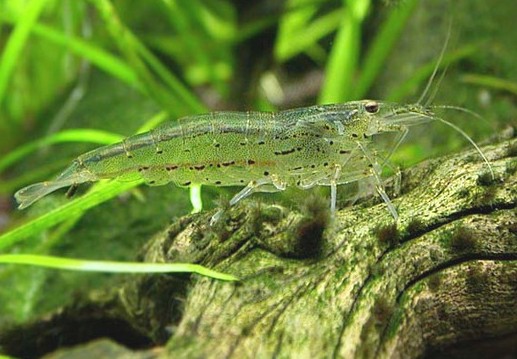Hello, Frank Indiviglio here. Until recently, freshwater shrimp have largely been ignored in the US aquarium trade. I’ve kept a few native species over the years, and was awed by some huge, long-clawed specimens that I collected and released in Costa Rica. But it wasn’t until I visited Japan several years ago that I became aware of the scores of small, colorful Asian and South American shrimps that were being bred and sold regularly there. Happily, most of those I came across at that time are now well established in the trade here in the USA.
Environment and Tankmates
 The following shrimps will co-exist with one another, provided the dietary needs of the specialists are met. All thrive at temperatures of 74-80 F and a pH range of 6.5-7.5. They do best in heavily planted aquariums with moderate water flow and, like many invertebrates, are very sensitive to ammonia. Many species appear somewhat social, congregating together, and most gravitate to and forage on driftwood if such is provided.
The following shrimps will co-exist with one another, provided the dietary needs of the specialists are met. All thrive at temperatures of 74-80 F and a pH range of 6.5-7.5. They do best in heavily planted aquariums with moderate water flow and, like many invertebrates, are very sensitive to ammonia. Many species appear somewhat social, congregating together, and most gravitate to and forage on driftwood if such is provided.
Freshwater shrimps may be housed with small, peaceful aquarium fishes, but will be attacked buy predatory species and crayfishes. I have had very good luck in keeping breeding groups with guppies, armored cats (Corydoras spp.) and hill stream, coolie and yo-yo loaches.
Feeding Shrimp
All the following species consume algae, with some favoring hair algae, but they also take a wide variety of flakes, pellets, carrion and organic detritus. Shrimp of all types are seemingly always foraging, day and night, and should be provided with a wide variety of food options.
In addition to live algae, I offer freshwater shrimps tropical fish flakes, shrimp pellets, spirulina tablets and live brine shrimp. If water quality is not an issue, it is also a good idea to allow them to feed upon an occasional small, dead fish.
Amano or Japanese Marsh Shrimp and Relatives, Caridina multidentata
This East Asian import was one of the first species established here, and is still a favorite. Please see the article referenced below for further information.
The closely related dwarf blackberry shrimp and emerald green shrimp, both native to Thailand, are beautifully patterned and may hybridize with the amano shrimp. All three prefer to feed upon hair algae, but will take a wide variety of other foods.
Bumblebee Shrimp, Caridina trifasciata
Another Japanese import, the bumblebee is strikingly marked in black and white and possessed of a squat build that makes it seem larger than its ¾ inches. Voracious scavengers as well as algae eaters, a group of these beautiful shrimps makes a spectacular display.
Orange Halo or Bee Shrimp, Caridina sp.
Favoring hair algae, this native of Thailand is bright orange in color and reaches ¾ inches in length. In common with its relatives, the orange bee shrimp does best in groups.
Pearl or Snowflake Shrimp, Macrobrachium mirabile
A giant among the dwarf shrimp, this long-clawed species may top 2 inches in length. It hails from India, where it favors the brackish water of river mouths. Captives do fine in freshwater, however, and make excellent scavengers. Despite its size, it is inoffensive to its smaller cousins.
Further Reading
For information on keeping the popular amano, cherry and bamboo shrimps, please see An Introduction to Freshwater Shrimps.
To learn more about a truly unique shrimp, please check out my article Keeping the African Giant Filter Shrimp.
Next time I’ll cover a few species that are rather new to the trade, as well as some more colorful and unique favorites. Please write in with your questions and comments. Thanks, until next time, Frank Indiviglio.
 That Fish Blog – Aquarium Advice and Information
That Fish Blog – Aquarium Advice and Information

